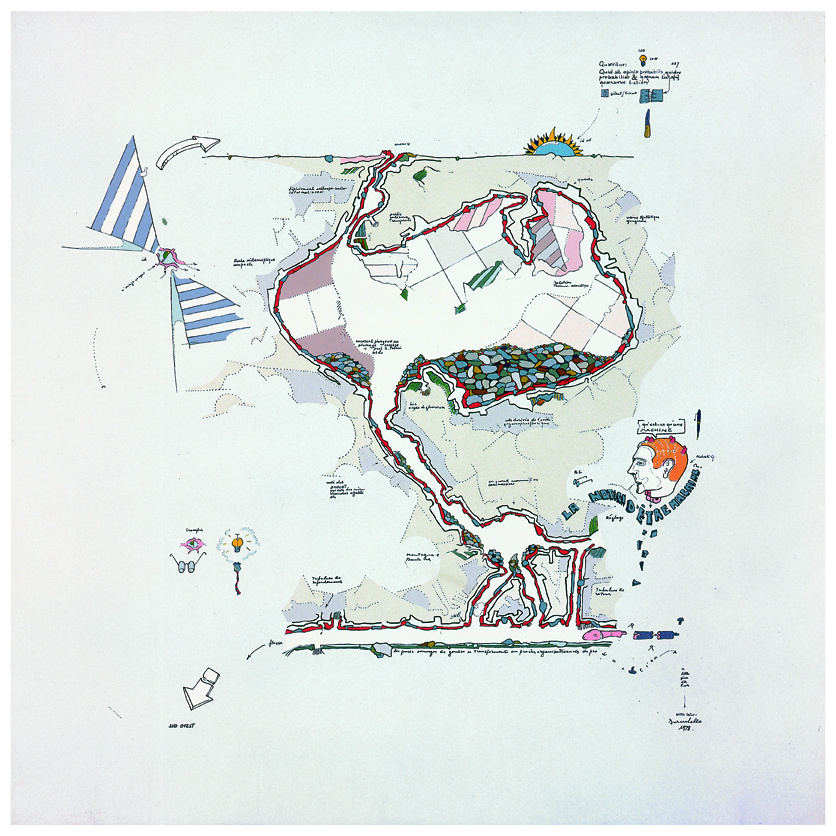- Exhibition
Gianfranco Baruchello. Certain Ideas
Sat, November 01, 2014 11:00 am – Mon, April 06, 2015 6:00 pm CEST
»Gianfranco Baruchello. Certain Ideas« shapes part of a loose series of ZKM exhibitions of artists who have either been consistently ignored by mainstream culture, or who have otherwise fallen into obscurity. However, it is precisely such artists who have often provided important impulses for the contemporary scene.
The comprehensive exhibition of the Italian multimedia artist Gianfranco Baruchello—organized in collaboration with the Deichtorhallen Hamburg / Falckenberg Collection—reviews half a century of artistic output, thereby presenting the astonishing versatility of Baruchello’s work by way of pictures, sculptures, object cabinets, collages, texts, and films created by the artist over several decades.
Gianfranco Baruchello (born in Livorno, in 1934, and currently living and working in Rome), was an active member of the European avant-garde movement during the 1960s. Driven by social utopias, he sought those connecting moments in art and science, life and art. He accomplished this fusion within different artistic media—including the foundation of a commune in the countryside.
Much like Marcel Duchamp with whom he was a close friend, Baruchello took pleasure in using found forms and objects. In this sense, he created works of abstract art from found objects in which autonomous elements fused together thus giving rise to new, extraordinary forms. He connected the strategies of Abstract Expressionism and Pop Art—which fascinated him ever since his journey through North America in 1964—with his own ideas to an extremely unique pictorial language. On white-ground canvasses, by means of miniscule everyday or surreal figures and symbols, Baruchello created complex worlds, whose structures are reminiscent of neural networks. He also developed a large number of object cabinets transferring the enigmatic figurative repertoire of the paintings to three dimensions.
In addition to his work using language, be it in the form of word games, rhyme experiments, or the design of individual publications, Baruchello also found his way to film. In 1964, he produced the 16-mm film »Verifica incerta«, which he assembled from found footage. Working with video and the experimental possibilities of this medium took on greater meaning for him throughout the 1970s and 1980s.
Following Baruchello’s participation in various international artists’ movements (e.g., Experiments in Art and Technology, Artiflex), the next logical step was the founding of a rural commune, the Agricola Cornelia S.p.A., in 1973. This was an expression of his ecological consciousness, the goal of which was the synergistic fusing of agriculture and art. He thus went further than many other contemporary artists who, though similarly inclined, ultimately failed to go beyond theoretical discourse. Numerous works of art in the exhibition testify to the current significance of thematic complexes, such as ecology and sustainability, themes that Gianfranco Baruchello had already introduced to art at an earlier stage.
The comprehensive exhibition of the Italian multimedia artist Gianfranco Baruchello—organized in collaboration with the Deichtorhallen Hamburg / Falckenberg Collection—reviews half a century of artistic output, thereby presenting the astonishing versatility of Baruchello’s work by way of pictures, sculptures, object cabinets, collages, texts, and films created by the artist over several decades.
Gianfranco Baruchello (born in Livorno, in 1934, and currently living and working in Rome), was an active member of the European avant-garde movement during the 1960s. Driven by social utopias, he sought those connecting moments in art and science, life and art. He accomplished this fusion within different artistic media—including the foundation of a commune in the countryside.
Much like Marcel Duchamp with whom he was a close friend, Baruchello took pleasure in using found forms and objects. In this sense, he created works of abstract art from found objects in which autonomous elements fused together thus giving rise to new, extraordinary forms. He connected the strategies of Abstract Expressionism and Pop Art—which fascinated him ever since his journey through North America in 1964—with his own ideas to an extremely unique pictorial language. On white-ground canvasses, by means of miniscule everyday or surreal figures and symbols, Baruchello created complex worlds, whose structures are reminiscent of neural networks. He also developed a large number of object cabinets transferring the enigmatic figurative repertoire of the paintings to three dimensions.
In addition to his work using language, be it in the form of word games, rhyme experiments, or the design of individual publications, Baruchello also found his way to film. In 1964, he produced the 16-mm film »Verifica incerta«, which he assembled from found footage. Working with video and the experimental possibilities of this medium took on greater meaning for him throughout the 1970s and 1980s.
Following Baruchello’s participation in various international artists’ movements (e.g., Experiments in Art and Technology, Artiflex), the next logical step was the founding of a rural commune, the Agricola Cornelia S.p.A., in 1973. This was an expression of his ecological consciousness, the goal of which was the synergistic fusing of agriculture and art. He thus went further than many other contemporary artists who, though similarly inclined, ultimately failed to go beyond theoretical discourse. Numerous works of art in the exhibition testify to the current significance of thematic complexes, such as ecology and sustainability, themes that Gianfranco Baruchello had already introduced to art at an earlier stage.
Imprint
- Curator
- Curator
Organizing Organization / Institution
ZKM | Karlsruhe
Accompanying program
